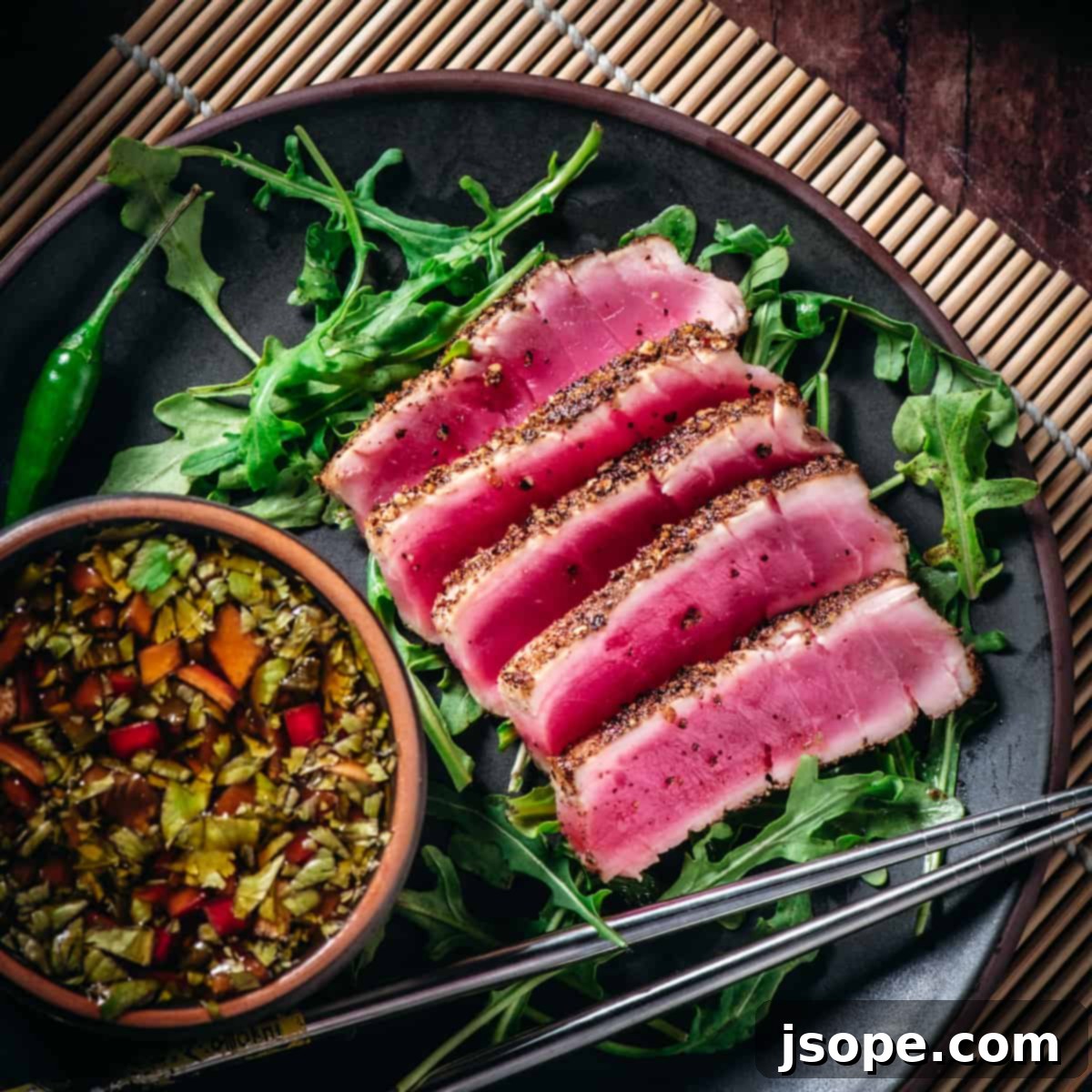There’s an undeniable magic to a perfectly prepared piece of fish, and for many, pepper-crusted seared ahi tuna holds a special place. The delicate balance of a crisp, peppery crust giving way to a buttery-soft, rare interior is a culinary delight, often enhanced by an exquisite dipping sauce. Traditionally, this dish graces menus alongside classic ponzu or other vibrant, citrusy sauces that complement the tuna’s rich flavor profile. Our shared affection for this sushi restaurant staple inspired us to bring this gourmet experience into our own kitchen, culminating in our signature Seared Ahi with Spicy Dipping Sauce. This rendition is not just delicious; it’s an experience we’re thrilled to share, offering a burst of flavor that’s incredibly versatile. Beyond enhancing our perfectly seared tuna, this dynamic sauce also elevates simple dumplings and adds an exciting kick when drizzled over a bowl of steamed rice, proving its worth as a kitchen essential.
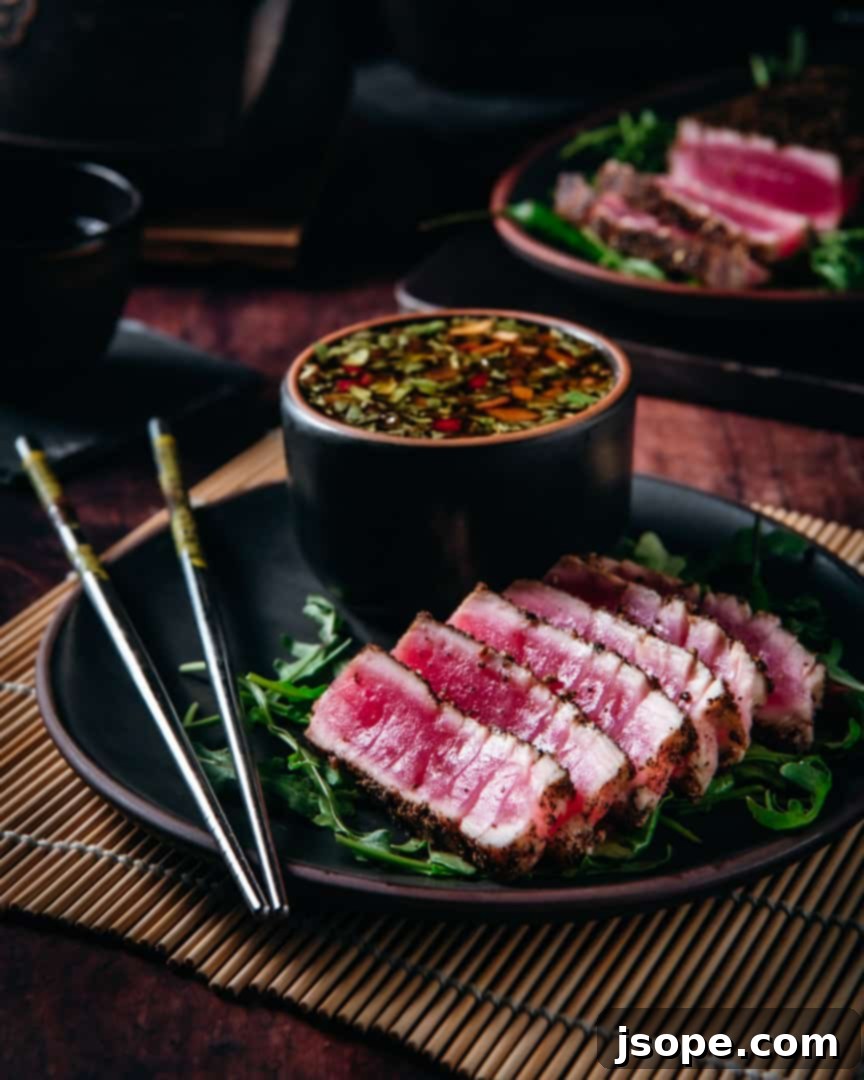
Crafting the Perfect Spicy Dipping Sauce: A Flavorful Journey
Our spicy dipping sauce is a testament to vibrant, fresh flavors, designed to awaken the palate. At its heart lies a bright, citrus-forward base, masterfully created with the zesty notes of fresh lemon and lime juice. These acidic components are beautifully balanced by the savory depth of soy sauce and the subtle tang of rice wine vinegar, forming a complex foundation. To this, we add a generous punch of freshly cracked black pepper for a warm, aromatic bite, finely chopped cilantro for herbaceous freshness, a diced jalapeño for a customizable heat, and finely minced red onions for a delicate sharpness. While the initial inspiration for this sauce undeniably stems from the beloved ponzu sauces we’ve savored in our favorite Japanese eateries, we want to be clear: this is our unique interpretation, not a claim to traditional ponzu or authentic Japanese cuisine. It’s a creative blend designed for modern palates. If your quest is for a strictly traditional ponzu sauce, you’ll find excellent authentic recipes HERE.
What truly sets our Spicy Dipping Sauce apart is its incredible depth and versatility. It’s more than just a condiment; it’s a flavor bomb that can dramatically brighten and transform almost any dish it accompanies. While it absolutely shines when paired with the robust, peppery crust of our seared ahi tuna, its charm extends far beyond. Imagine drizzling it over steamed vegetables for a healthful and flavorful boost, stirring it into a simple noodle dish for an instant upgrade, or using it as a vibrant marinade for grilled chicken or tofu. The citrus and spice notes cut through richness, adding a refreshing zing, while the umami from the soy sauce provides a satisfying backbone. You can easily adjust the spice level to your preference: for a milder kick, remove the seeds and white membrane from the jalapeño; for those who crave more heat, consider adding a touch of serrano pepper or a pinch of red pepper flakes. This adaptability makes our sauce a powerful secret weapon in your culinary arsenal, capable of adding an extraordinary layer of flavor to countless meals.
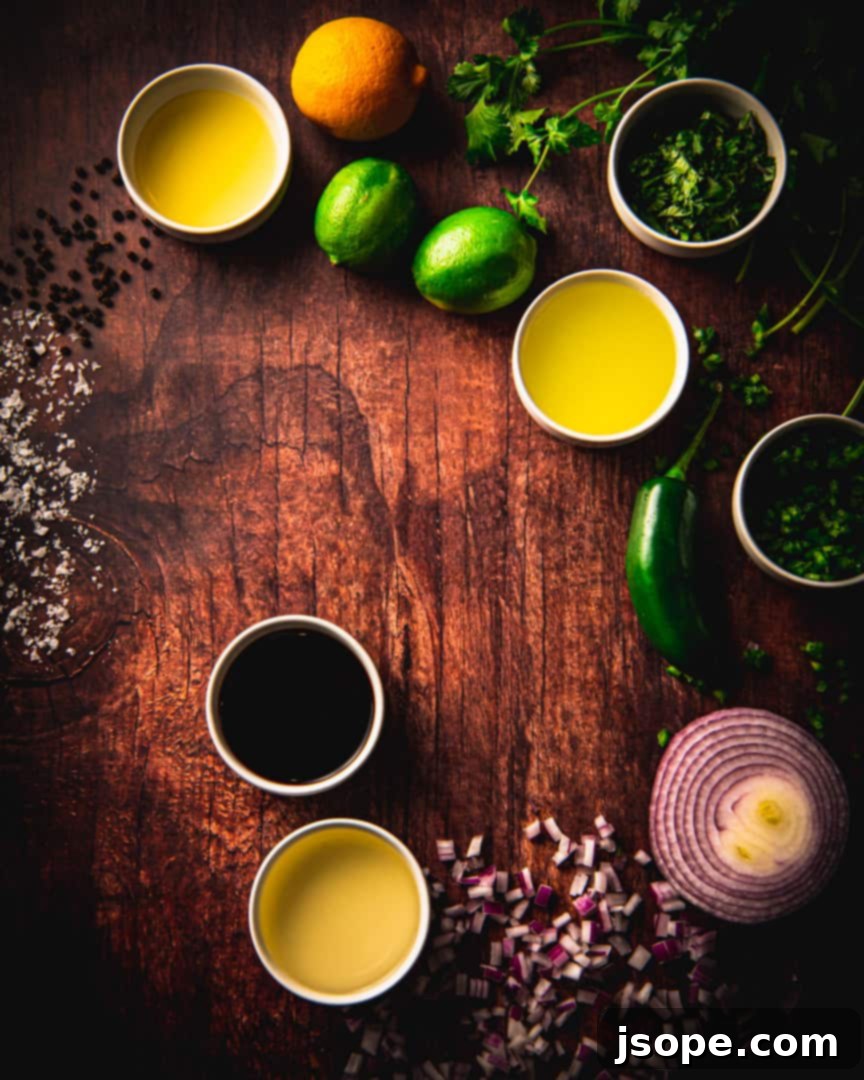
For those who love exploring diverse dipping sauces for seafood, we highly recommend trying this vibrant Thai Green Chili Sauce (Nam Jim Talay) – another fantastic option to tantalize your taste buds.
Navigating the Waters: Sourcing Sushi/Sashimi Grade Tuna
One of the most crucial, and potentially most challenging, aspects of recreating this restaurant-quality dish at home is sourcing genuine sushi or sashimi grade tuna. The quality of your fish directly impacts not only the flavor and texture but, more importantly, the safety of consuming it rare or raw. The terms “sashimi grade” or “sushi grade” indicate that the fish has been processed and handled in a way that the seller deems safe for raw consumption. This typically means it has been caught, bled, cleaned, and flash-frozen at extremely low temperatures shortly after harvest to eliminate parasites. However, it’s vital to understand that there is no official federal grading agency or standardized certification that dictates what “sushi grade” means across the board. This puts the onus on the consumer to exercise caution and diligence. Always purchase your fish from a reputable and trusted source known for their high standards in seafood handling and freshness.
When searching for top-quality tuna, a great starting point is often a well-regarded Asian market. Many such markets specialize in seafood suitable for raw consumption and have a higher turnover, ensuring fresher stock. Alternatively, specialty fishmongers or high-end grocery stores with dedicated seafood counters are excellent resources. In Houston, for instance, we’ve consistently found excellent Hawaiian Select Ahi Steaks, often flash-frozen, at Central Market. When inspecting tuna, look for a vibrant, deep red color without any browning or discoloration. The flesh should be firm and moist, not mushy or dry, and it should have a fresh, ocean-like smell, not a strong, fishy odor. Avoid tuna that looks dull, has gaps in its flesh, or emits an ammonia-like smell. These are clear indicators of poor quality.
While online purveyors of sashimi grade fish have become more common, offering convenience and a wider selection, we haven’t personally tested any specific ones to provide a confident recommendation. If you choose to buy online, research thoroughly, check reviews, and verify their sourcing and shipping practices. It’s imperative to confirm they maintain proper cold chain management to ensure the fish remains frozen and safe during transit.
If you find yourself unable to locate sushi-grade tuna, or if you prefer a fully cooked option, you can certainly use a regular tuna steak. However, a significant adjustment must be made: you will need to cook the tuna thoroughly to ensure any potential bacteria or parasites are destroyed. This means cooking it past the rare stage, which will alter the texture and flavor considerably from the traditional seared ahi experience, making it more akin to a cooked steak. Always remember, when consuming anything raw or undercooked, taking appropriate precautions is paramount. Educate yourself about food safety guidelines, research your food sources diligently, and make informed choices to protect your health and enjoy your meal safely.
Mastering the Sear: Achieving Ahi Tuna Perfection
The beauty of seared ahi tuna lies in its simplicity and the precision of its cooking technique. Achieving that coveted crispy, peppery crust with a cool, tender, and rare interior requires high heat and swift execution. Here’s how to perfect your sear and truly appreciate the quality of your tuna steak.
Preparing Your Tuna for the Perfect Crust
Before you even think about the heat, proper preparation of your tuna steak is key. Start by patting the tuna completely dry with paper towels. Moisture is the enemy of a good sear, as it will steam the fish rather than allow it to crisp. Once dry, season generously. For our pepper-crusted version, this means a liberal coating of coarse crushed black peppercorns. Don’t be shy; press the peppercorns firmly into both sides of the tuna steak so they adhere well and form a substantial crust. A sprinkle of sea salt is also essential to enhance the flavor and aid in browning.
The Art of High-Heat Searing
The secret to a perfect sear is a screaming hot pan. A heavy cast-iron skillet is ideal because it retains heat exceptionally well, providing an even and intense cooking surface. Place your cast iron skillet on the stove over high heat and allow it to preheat until it is smoking hot – you should see wisps of smoke rising from the pan. This typically takes a few minutes. Once the pan is ready, add a high-smoke-point oil, such as canola, grapeseed, or light olive oil. Avoid extra virgin olive oil as it has a lower smoke point and can burn, imparting a bitter flavor. Swirl the oil to coat the pan, then wait about 10 seconds for it to heat up.
Carefully place the seasoned tuna steak into the hot skillet. You should hear an immediate, satisfying sizzle. The cooking time is incredibly brief, designed to create that distinct contrast between the seared exterior and raw interior. For a beautifully rare center, cook the tuna for approximately one minute per side. This timing can vary slightly depending on the thickness of your tuna steak and your personal preference for doneness. A thicker steak might need an extra 30 seconds per side, while a thinner one could be done in less time. Visually, you’re looking for a noticeable change in color on the edges, turning opaque white, while the center remains vibrant red. If you prefer a medium-rare tuna, you might extend the cooking time to 1.5 to 2 minutes per side, but be cautious not to overcook, as tuna can become dry and tough quickly.
Resting and Slicing
Once seared to perfection, remove the tuna from the pan and place it on a cutting board. It’s crucial to let the tuna rest for a few minutes before slicing. This allows the juices to redistribute throughout the flesh, ensuring a more tender and flavorful result. After resting, slice the tuna against the grain into thick, bite-sized pieces. Slicing against the grain shortens the muscle fibers, making each piece incredibly tender. Arrange the slices artfully on a plate and serve immediately with your vibrant Spicy Dipping Sauce. The combination of the warm, peppery crust, the cool, tender interior, and the zesty, spicy sauce creates an unforgettable culinary experience.



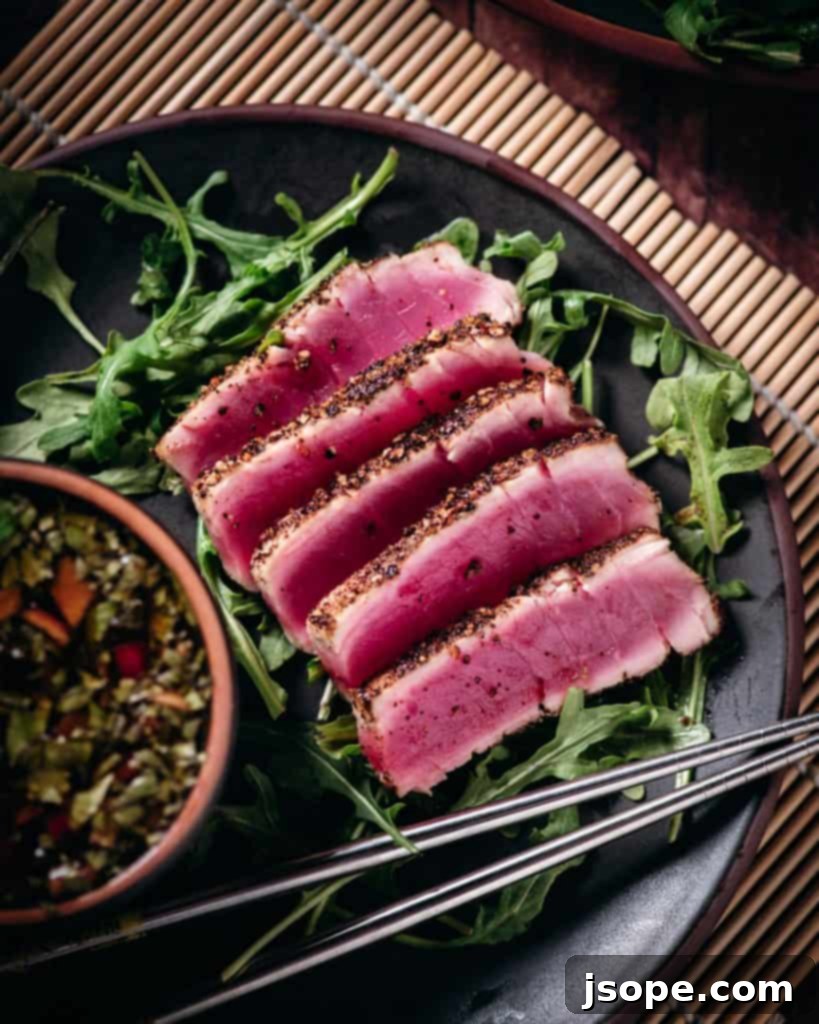
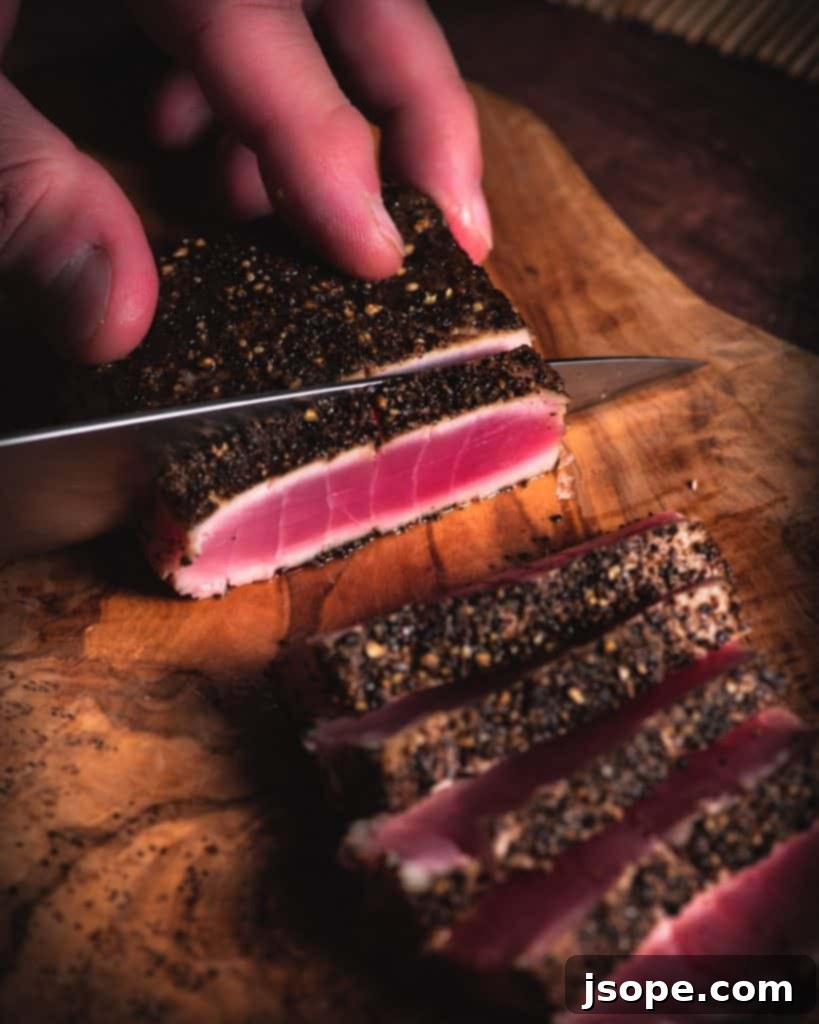

Serving Suggestions and Perfect Pairings
While Seared Ahi Tuna with Spicy Dipping Sauce is undeniably a showstopper on its own, thoughtful accompaniments can elevate it to a complete and unforgettable meal. Consider serving this vibrant dish alongside a bed of perfectly steamed jasmine or sushi rice, allowing the rice to absorb the subtle flavors of the tuna and the zesty sauce. For a lighter touch, a crisp, refreshing Asian-inspired salad featuring thinly sliced cucumbers, carrots, and a light vinaigrette would provide a delightful textural contrast. Roasted or stir-fried vegetables, such as asparagus, bok choy, or bell peppers, can add an earthy sweetness that complements the rich tuna beautifully. The versatility of the spicy dipping sauce means it can also be drizzled over these sides, unifying the flavors of the entire plate.
When it comes to beverages, choose options that enhance rather than overpower the delicate flavors of the ahi tuna. A dry sake or a crisp, unoaked white wine like Sauvignon Blanc or Pinot Grigio would be excellent choices, their acidity cutting through the richness of the fish and balancing the spice of the sauce. For non-alcoholic options, unsweetened iced green tea or sparkling water with a hint of lemon or lime would provide a refreshing counterpoint. Remember, the goal is to create a harmonious dining experience where each component plays a role in highlighting the star of the show: your perfectly seared ahi tuna.
Health Benefits of Ahi Tuna
Beyond its incredible flavor, ahi tuna is also a powerhouse of nutrition, making this dish a healthy indulgence. It’s an excellent source of lean protein, essential for muscle repair and growth, and remarkably low in calories. Ahi tuna is particularly renowned for its high content of Omega-3 fatty acids, specifically EPA and DHA. These “good fats” are crucial for heart health, brain function, and reducing inflammation throughout the body. Additionally, tuna provides vital vitamins and minerals, including B vitamins (B6, B12, niacin) which are important for energy metabolism, and minerals like selenium, which acts as an antioxidant, and potassium. By enjoying seared ahi tuna, you’re not just treating your taste buds; you’re nourishing your body with a wealth of beneficial nutrients.
Troubleshooting and FAQs
Even seasoned home cooks can encounter small challenges when preparing a dish like seared ahi tuna. Here are some common questions and tips to ensure your culinary success:
- Why is my tuna not searing properly, or sticking to the pan? The most common culprits are insufficient heat or a pan that isn’t completely dry. Ensure your cast iron skillet is smoking hot before adding the oil and tuna. Also, make sure your tuna steak is thoroughly patted dry to prevent steaming. A well-seasoned cast iron pan or a good non-stick pan can also help prevent sticking.
- Can I use a different type of fish with this sauce? Absolutely! While ahi tuna is traditionally paired with this style of sauce, the spicy dipping sauce is incredibly versatile. It would pair wonderfully with other firm, white fish like mahi-mahi or swordfish, particularly if grilled or pan-fried. For a lighter option, try it with perfectly seared scallops or even grilled shrimp. Just remember to adjust cooking times for different fish types.
- How do I store leftovers? Seared ahi tuna is best enjoyed fresh, immediately after cooking, especially if you prefer it rare. The texture changes significantly upon refrigeration. If you have leftovers, store them in an airtight container in the refrigerator for up to 1-2 days. It’s generally not recommended to reheat rare tuna, as it will cook further and lose its desired texture. Leftover tuna can be flaked and added to salads or eaten cold. The spicy dipping sauce can be stored separately in an airtight container in the refrigerator for up to 3-4 days.
- How can I adjust the spice level of the sauce? For a milder sauce, remove all seeds and the white membrane from the jalapeño. For an extra kick, you can leave some seeds in, or even substitute a serrano pepper for the jalapeño. A pinch of red pepper flakes can also be added for an immediate heat boost.
Enjoy Your Culinary Creation!
We genuinely hope you find as much joy in preparing and savoring this Seared Ahi with Spicy Dipping Sauce recipe as we do. It’s a dish that brings a touch of gourmet elegance to any meal, proving that restaurant-quality flavors are well within reach in your own kitchen. If you decide to give this recipe a try, we’d absolutely love to hear from you! Please leave us a comment below to share your experience or, even better, tag us on Instagram @cooking_with_wine so we can see your beautiful creations. Your feedback and photos inspire us to keep sharing delicious recipes!
For more delectable culinary adventures, be sure to explore some of our other popular recipes linked below. We’re constantly discovering and crafting new dishes, and we’re excited for you to try them all:
- Delicious Red Snapper Amandine
- Blackened Garlic Shrimp Tacos with Cilantro Cream Sauce
- Grilled Salmon with Passion Fruit Glaze
- Perfectly Seared Scallops
- Spicy Ginger Garlic Shrimp Skewers
📖 Recipe
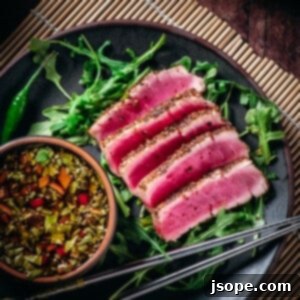
Seared Ahi with Spicy Dipping Sauce
Pin Recipe
Equipment
- 1 Cast iron skillet
Ingredients
Spicy Dipping Sauce
- 4 ounces lime juice approx 2-3 limes strained
- 3 ounces low sodium soy sauce
- 2 ounces rice wine vinegar
- ½ ounce lemon juice approx 1 small lemon strained
- ½ teaspoon black pepper
- ⅓ cup cilantro chopped
- 1 medium jalapeño or serrano if you like spicy, seeded and diced fine
- ⅓ medium red onion diced fine
Pepper Crusted Ahi Tuna
- 10-12 ounce sushi-grade tuna steak
- 2-3 tablespoon course crushed black peppercorns
- 1 teaspoon salt
- 2 teaspoon Canola grapeseed or olive oil
Instructions
Make the Sauce
- Combine all ingredients in a bowl and set aside until ready to use. If preparing in advance, refrigerate until later that day.
Prepare and Cook the Ahi Tuna
- Heat a heavy cast iron skillet over high heat until smoking. While the skillet heats, generously coat both sides of the tuna steak with coarse crushed black peppercorns, pressing them firmly into the flesh to create a robust crust.
- Once the skillet is smoking hot, add your chosen high-smoke-point oil (Canola, grapeseed, or olive oil). Wait approximately 10 seconds for the oil to heat, then gently place the tuna into the skillet. Cook for 1 minute per side. This timing typically yields a perfectly seared exterior with a beautifully rare, raw interior. Adjust cooking time slightly based on the thickness of your tuna and your desired level of doneness.
- Remove the seared tuna from the pan and let it rest for a few minutes. Then, slice it against the grain to achieve tender, bite-sized pieces. Serve immediately with the homemade Spicy Dipping Sauce.
